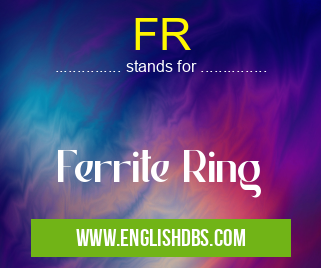What does FR mean in PHYSICS
Ferrite Ring (FR) is a type of inductor used in electronic circuits. It consists of a toroidal (ring-shaped) core made of a ferrite material, which is a non-conductive ceramic compound of iron oxide and other metal oxides.

FR meaning in Physics in Academic & Science
FR mostly used in an acronym Physics in Category Academic & Science that means Ferrite Ring
Shorthand: FR,
Full Form: Ferrite Ring
For more information of "Ferrite Ring", see the section below.
Components and Construction
An FR typically consists of the following components:
- Ferrite Core: The ring-shaped core is made of a ferrite material, which provides high inductance and low losses.
- Winding: An insulated wire is wound around the core in a specific pattern to create the inductor.
- Terminals: The winding is connected to terminals that allow the FR to be integrated into electronic circuits.
Properties and Applications
FRs possess several important properties that make them suitable for various applications:
- High Inductance: FRs have high inductance values, which allow them to store magnetic energy.
- Low Core Losses: Ferrite materials exhibit low core losses, resulting in high efficiency.
- Compact Size: FRs have a compact size and can be easily integrated into printed circuit boards (PCBs).
- Wide Frequency Range: FRs can operate over a wide frequency range, making them suitable for different applications.
Applications
FRs are widely used in electronic circuits, including:
- Inductors: In power supply circuits, FRs serve as inductors that regulate current flow and reduce voltage fluctuations.
- Filters: FRs are used in filters to suppress unwanted frequency components in electronic signals.
- Transformers: FRs can be used as transformers to isolate and transform voltage levels between circuits.
- Resonators: In resonant circuits, FRs are used to create resonant frequencies and enhance signal processing.
Essential Questions and Answers on Ferrite Ring in "SCIENCE»PHYSICS"
What is a Ferrite Ring?
A Ferrite Ring (FR) is a type of electromagnetic core made of a ceramic material known as ferrite. Its primary function is to concentrate magnetic flux and enhance the performance of inductors, transformers, and other magnetic components.
What materials are used to make Ferrite Rings?
Ferrite Rings are typically composed of mixed metal oxides, such as iron oxide (Fe2O3) combined with other metal oxides like nickel, manganese, zinc, or magnesium. These oxides are sintered at high temperatures to form a polycrystalline ceramic material with magnetic properties.
What are the advantages of using Ferrite Rings?
Ferrite Rings offer several advantages:
- High magnetic permeability: They can effectively concentrate magnetic flux, resulting in higher inductance and lower losses.
- Low electrical conductivity: Ferrite Rings have low eddy current losses, making them suitable for high-frequency applications.
- Temperature stability: They exhibit relatively stable magnetic properties over a wide temperature range.
- Cost-effective: Ferrite Rings are generally less expensive than other core materials, such as iron or powdered iron cores.
What are the different types of Ferrite Rings?
Ferrite Rings come in various shapes, sizes, and permeability values. The most common types include:
- Toroidal Cores: Ring-shaped cores with a circular cross-section, providing high inductance and low losses.
- E-Cores: U-shaped cores with a rectangular cross-section, used in transformers and inductors.
- Pot Cores: Cylindrical cores with a closed magnetic circuit, suitable for high-power applications.
What are the applications of Ferrite Rings?
Ferrite Rings are widely used in electronic components and devices, including:
- Inductors: To store energy and control current flow in electronic circuits.
- Transformers: To isolate and transfer electrical energy between circuits.
- Antennas: To enhance signal reception and transmission.
- Magnetic sensors: To detect and measure magnetic fields.
Final Words: Ferrite Rings (FRs) are versatile inductors that offer high inductance, low core losses, compact size, and a wide frequency range. Their properties make them suitable for a variety of electronic applications, including power supply circuits, filters, transformers, and resonators. FRs contribute to the efficient operation and functionality of various electronic devices.
FR also stands for: |
|
| All stands for FR |
